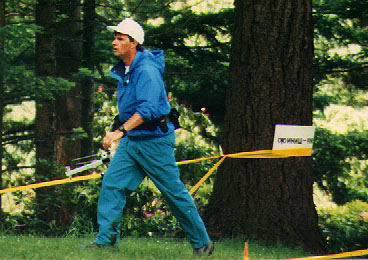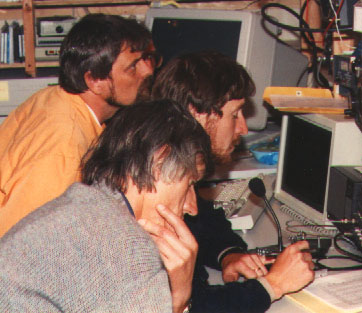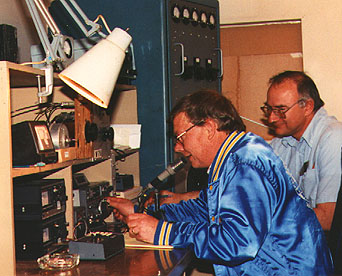
Yoshiko Yamagami JQ1LCW is a champion at "fox-teering," as it's called in Japan. But she had never used an American switched-antenna RDF set. Still, she finished fourth out of 15 entrants in the FRG-91 foxhunt.
This article originally appeared as a feature in the November 1991 issue of 73 Amateur Radio Today Magazine.
In an ordinary DX competition, the contestants stay in their shacks in their own countries. They link with each other via the ether for only a few seconds, two at a time. Months later, they read the results in a magazine.
That's fun. But now, imagine an international Amateur Radio competition where the entrants spend a week together. They stay in one another's homes. They dine in large groups. Their families become good friends. They challenge each other in the usual time-honored hamshack events, plus Morse contests and radio direction finding "foxhunts." The results are known immediately. There are opening ceremonies and a closing banquet, followed by misty-eyed goodbyes.
More fun? You bet. At least 20 dB more, I'd say. Continent-wide radiosporting contests like this have been regular events in Europe and Asia for many years, but they are new to the USA. That's changing, thanks to the Friendship Amateur Radio Society (FARS).
FARS is a not-for-profit organization based in Portland, Oregon. It has a counterpart organization in Khabarovsk, a city of similar size in eastern USSR. During the summer of 1989, a group of hams from Portland went to Khabarovsk for a week of radiosporting activities.
In 1991, it was Portland's turn to host. During the week after Memorial Day, FARS-USA welcomed hams to the second Friendship Radiosport Games (FRG-91). There were all the events usually found at a European/Asian radiosport festival, including DX contests, a CW competition, and the first internationally sanctioned foxhunt in the USA. On hand to compete were ten Soviet, three Japanese, and twenty US hams.
In the USA, the commonplace radio direction finding (RDF) contests are called hidden transmitter hunts or T-hunts. They involve cars, trucks, and vans outfitted with strange antennas and blinking consoles. It's more like a road rallye than a race. International radiosport RDF, usually called foxhunting, allows no such luxury. It's all done on foot. Speed determines the winner. So there's no place for the unfit.

Yoshiko Yamagami JQ1LCW is a champion at "fox-teering," as it's called in Japan. But she had never used an American switched-antenna RDF set. Still, she finished fourth out of 15 entrants in the FRG-91 foxhunt.
The site was Portland's Forest Park, a giant wooded labyrinth of trails, trees, and hills. The weather alternated between rain and sun. Somewhere in those 200 rugged acres were five yellow metal boxes, each transmitting a few milliwatts on 146.565 MHz. Fox number one came on for one minute, then number two, and so on. To win the event, all you had to do was be the first to find all five, in numerical order, and get back to the start/finish line.
Sound easy? You try it! Even the winners, seasoned Northwest ELT Team members and intrepid southern California T-hunters, got a real workout. Since each transmitter is on the air only 20 per cent of the time, it's important to plot the bearings to each one often, and carefully triangulate on the maps provided.

Kevin Kelly N6QAB won the foxhunt by finding all five transmitters on the two-mile course in less than one and a quarter hours.
It was a dual challenge---physical stamina and technical expertise were needed to win. Almost all were headed for the liniment and foot baths after the rigors of this event.
There was little time for recuperation after the foxhunt; the DX competition was the next day. Five of Portland's best-equipped hamshacks (W7NI, K2RAG, W7EJ, WR7D, and K7RO) rolled out the red carpet to the five international teams.

These Morse experts on the USSR-Red team made the most CW contacts in FRG-91. They are (front to back) Slava Alexandrov UWØCD, Mikhail Zavarukhin UWØCN, and Igor Krivosheev UAØCZ, in the computer-filled shack of WR7D.
To insure that no team had an advantage or disadvantage because of the features of a particular station, the teams rotated. Each team spent one hour at each station, with an hour off for travel between operating periods. Thus the contest period was nine hours, with only five hours actual on-air time.
By now, the competitors sensed that Murphy had connections with Old Sol as well as with the weatherman. Band conditions were anything but hot. Hopes by the Soviets and Japanese of racking up scads of contacts with their homelands were not to be realized.
The three-page set of rules for the HF test included "counters" for countries and US/VE/JA prefixes. To insure accuracy, there was a three-QSO penalty for "busted calls," plus additional penalties for incomplete exchanges and invalid QSOs. All logging was done on computers provided by FARS. The sponsors also provided assistants to enter calls into the computers in real time.

At W7NI's super-station: A good balance of SSB QSOs, CW QSOs, and "counters" captured the gold for the US-Blue team, including Jim Fenstermaker K9JF (left) and Paul Kiesel K7CW (right).
Pressing their home court advantage, US teams took the gold and silver. A USSR team was in third place, despite having fewer total QSOs than the Japanese team. The JAs made no CW contacts, which put them at a major disadvantage in the convoluted scoring system.
Friday night, it was time to take off to Seaside, Oregon, a coastal vacation spot eighty miles northwest of Portland, for the remainder of the events. The Sea-Pac convention that weekend gave the foreign entrants a chance to meet hundreds of US hams. It also attracted the northwest's top CW operators to take them on.

Don Calbick W7GB (left) took second place in the brutal CW pileup test. Harry Lewis W7JWJ (right) won the gold for high speed CW receiving.
After a leisurely practice session at 20 WPM, Mark Sinnard N6OPN cranked up the computer and let the dits and dahs fly for the high-speed receiving test. By the end of the 35 WPM round, only three entrants were able to copy for a solid minute. Based on their accuracy in that round, the individual medal winners were selected.
But Mark wasn't through with his torture---it was time for the pileup contest. By this time, hunger and other activities had lured some of the world-class CW experts out of the FARS room onto the convention floor. There was a shortage of contestants, so I grabbed a pencil and a set of earphones, then sat down in one of the empty seats.
The pileup tape began with a plaintive "QRZ DX" by W2NSD/1. (Now where have I heard that call before?) For the next six minutes, it was non-stop CW bedlam ringing in my head, as no less that 101 rare stations called poor Wayne. They were all on top of one another, at varying levels, with lots of noise and QRN mixed in.
What a mess! Somehow I managed to scribble down enough callsigns to stay out of last place. But my list had nowhere near the 34 calls that winner Jim Fenstermaker K9JF got. How does he do it?
There was no lack of entrants for the next event: CW sending. Even Dima Ornatsky, the 12-year-old SWL grandson of RWØCA, gave it a try.
The Soviet sending style is much different from the traditional J-38 grasp of American hams. Russian straight keys have a big knob on them and are placed at the very edge of the table. These fellows used their arms as much as their wrists. They did well, but couldn't top "Faster than Baudot" Dale Jones K5MM.

Bob Bergert KØPB (left), Dale Jones K5MM (right), and J. Scott Bovitz N6MI (rear table) make fast CW receiving seem easy. Dale took first place and Scott took third.
When the final scores for all events were tallied, there was a tie for the gold between the Red and Blue teams from the USA. The USSR-Blue team took the bronze. But there was no talk of victory or defeat at the awards ceremony, just a celebration of the international camaraderie that Amateur Radio can provide.
The future is bright for international radiosporting events. FARS is already planning for the next Friendship Radio Games. Start training now---you could become an internationally famous ham radio athlete!
FRG-91 INDIVIDUAL MEDALISTS
(Calls indicate nationality)
EVENT FIRST SECOND THIRD
Foxhunt Kevin Kelly N6QAB Mike McCarter KA7NOO Lewis Osborn KC7MZ
CW Receiving Harry Lewis W7JWJ Dale Jones K5MM J. Scott Bovitz N6MI
CW Pileup Jim Fenstermaker K9JF Don Calbick W7GB Al Rovner WA2TMP
CW Sending Dale Jones K5MM Mikhail Zavarukhin UWØCN Vlad Gorelik RWØCA
FRG-91 TEAM MEDALS
EVENT FIRST SECOND THIRD
Foxhunt USA-Red USA-Blue Japan
(KA7NOO, KC7MZ, WB6JGV) (N6QAB, N6MI) (JQ1LCW, JN1JPX, JR1WYB)
Operating USA-Blue USA-Red USSR-Blue
(W7RM, K9JF, W7WA, K7CW) (W3XY, WA7VTD, AI7B, WB7RFA) (UWØCA captain)
CW Pileup USA-Red USSR-Blue USA-Blue
(W7GB, WA2TMP) (UAØCZ, UWØCD) (K9JF, N6MI, KØOV)
CW Sending USA-Blue USSR-Red USA-Red
(K5MM, W7GB, W7VSE) (RWØCA, UAØCDX, UWØCA) (WA7VTD, WAØDIM, W7JWJ)
FRG-91 SPONSORS AND DONORS
(in alphabetical order)
AEA CW Sending eqpt.
BMG Engineering RDF Sets
Delta Airlines Transportation
Gates Energy Products Batteries
Kenwood USA Hand-helds
Ron Seese N6MBR Fox controllers
© 1991 and 2008 Joseph D. Moell. All rights reserved.

 Back to the Championships Foxhunting News page
Back to the Championships Foxhunting News page
Back to the Homing In home page
This page updated 11 September 2008